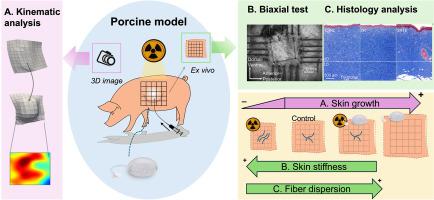在猪模型中,组织扩张可减轻辐射引起的皮肤纤维化。
IF 9.4
1区 医学
Q1 ENGINEERING, BIOMEDICAL
引用次数: 0
摘要
组织扩张术(TE)是乳房切除术后乳房重建的主要方法。在许多情况下,乳房切除术患者都要接受放射治疗(XR)。众所周知,辐射会诱发皮肤纤维化,是乳房切除术后乳房重建并发症的主要原因之一。另一方面,TE 可诱导一种促进再生的反应,最终导致新皮肤的生长。然而,XR 和 TE 对皮肤力学的综合影响尚不清楚。在这里,我们使用猪 TE 模型,通过双轴测试、组织学分析和皮肤随时间变形的运动学分析,研究辐射对皮肤纤维化的影响。我们发现,与对照组相比,XR 会导致皮肤变硬,其基础是过渡伸展(胶原组织特有的低硬度和指数应力-应变区域之间的过渡)的变化。组织学图像中测量到的更粗更整齐的胶原纤维束可以解释过渡伸展的变化。接受 XR+TE 的皮肤显示出与对照组相似的微观结构以及相似的双轴响应,这表明 TE 诱导的胶原蛋白生理性重塑部分抵消了 XR 的促纤维化效应。采用运动学方法间接评估了皮肤的生长情况,该方法量化了永久面积变化的增加,而厚度没有减少,这表明即使在放射治疗的情况下,TE 也能促进新组织的生成。未来的工作将重点研究 TE 抵消辐射诱导的纤维化的详细生物机制。意义说明:乳腺癌是女性的高发病,其治疗通常会导致乳房全部切除(乳房切除术),然后使用组织扩张器进行重建。约有三分之一的乳房重建病例使用放射治疗,但放射治疗会导致严重的并发症。放射治疗的时机仍存在争议。众所周知,辐射会造成直接的皮肤损伤和长期的纤维化。组织扩张会导致包括胶原重塑在内的促再生反应。在这里,我们展示了在辐射前立即进行组织扩张可以减少辐射引起的纤维化程度。因此,我们预计这一新证据将为研究如何利用组织扩张的胶原重塑和促进再生效应来预防辐射引起的纤维化开辟新的途径。本文章由计算机程序翻译,如有差异,请以英文原文为准。

Tissue expansion mitigates radiation-induced skin fibrosis in a porcine model
Tissue expansion (TE) is the primary method for breast reconstruction after mastectomy. In many cases, mastectomy patients undergo radiation treatment (XR). Radiation is known to induce skin fibrosis and is one of the main causes for complications during post-mastectomy breast reconstruction. TE, on the other hand, induces a pro-regenerative response that culminates in growth of new skin. However, the combined effect of XR and TE on skin mechanics is unknown. Here we used the porcine model of TE to study the effect of radiation on skin fibrosis through biaxial testing, histological analysis, and kinematic analysis of skin deformation over time. We found that XR leads to stiffening of skin compared to control based on a shift in the transition stretch (transition between a low stiffness and an exponential stress-strain region characteristic of collagenous tissue) and an increase in the high modulus (modulus computed with stress-stretch data past the transition point). The change in transition stretch can be explained by thicker, more aligned collagen fiber bundles measured in histology images. Skin subjected to both XR+TE showed similar microstructure to controls as well as similar biaxial response, suggesting that physiological remodeling of collagen induced by TE partially counteracts pro-fibrotic XR effects. Skin growth was indirectly assessed with a kinematic approach that quantified increase in permanent area changes without reduction in thickness, suggesting production of new tissue driven by TE even in the presence of radiation treatment. Future work will focus on the detailed biological mechanisms by which TE counteracts radiation induced fibrosis.
Statement of significance
Breast cancer is the most prevalent in women and its treatment often results in total breast removal (mastectomy), followed by reconstruction using tissue expanders. Radiation, which is used in about a third of breast reconstruction cases, can lead to significant complications. The timing of radiation treatment remains controversial. Radiation is known to cause immediate skin damage and long-term fibrosis. Tissue expansion leads to a pro-regenerative response involving collagen remodeling. Here we show that tissue expansion immediately prior to radiation can reduce the level of radiation-induced fibrosis. Thus, we anticipate that this new evidence will open up new avenues of investigation into how the collagen remodeling and pro-regenerative effects of tissue expansion can be leverage to prevent radiation-induced fibrosis.
求助全文
通过发布文献求助,成功后即可免费获取论文全文。
去求助
来源期刊

Acta Biomaterialia
工程技术-材料科学:生物材料
CiteScore
16.80
自引率
3.10%
发文量
776
审稿时长
30 days
期刊介绍:
Acta Biomaterialia is a monthly peer-reviewed scientific journal published by Elsevier. The journal was established in January 2005. The editor-in-chief is W.R. Wagner (University of Pittsburgh). The journal covers research in biomaterials science, including the interrelationship of biomaterial structure and function from macroscale to nanoscale. Topical coverage includes biomedical and biocompatible materials.
 求助内容:
求助内容: 应助结果提醒方式:
应助结果提醒方式:


